A guide to the decades-long conflict in DR Congo
The resource-rich country, now facing a major rebel attack, has been racked by conflict for more than 30 years.
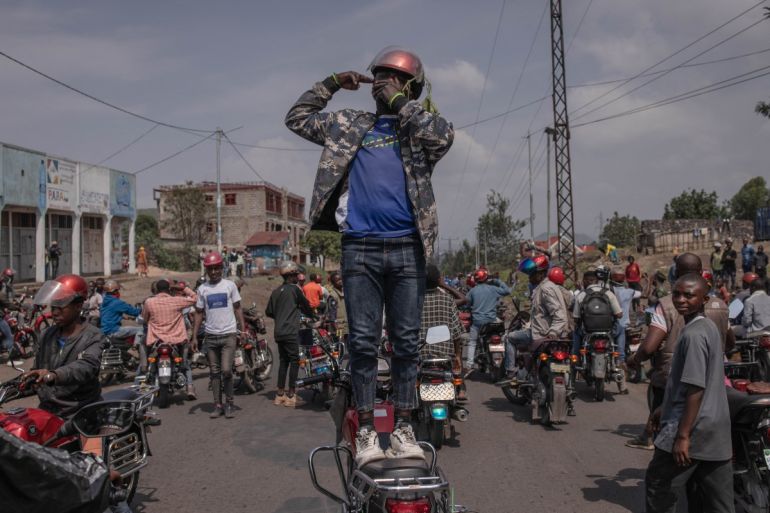
Escalating tensions in the Democratic Republic of the Congo (DRC) have once again drawn global attention to the security crisis in the African country’s mineral-rich eastern region.
Heavy fighting between the Congolese armed forces (FARDC) and the M23 rebel group in the country’s troubled North Kivu province has forced thousands of civilians to flee their homes in the past two weeks, taking what little they can. Dozens have been killed and hundreds of thousands displaced since January.
There are fears that the regional capital, Goma – home to some two million people and about half a million displaced people seeking refuge there – could soon fall to an advancing M23, a potentially devastating blow to the Congolese government’s control of the region.
The UN Security Council voiced concern at the “escalating violence” after M23 shelled Goma airport, damaging Congolese military aircraft.
Racked by conflict for more than 30 years, the DRC’s insecurity is caused by complex and deep-seated factors, as well as a multitude of actors. Apart from the M23, numerous other armed groups, Congolese and foreign forces are battling for control, mostly in the eastern part of the country. Some of Kinshasa’s neighbours are also implicated in the crisis.
Approximately six million people have been killed since 1996 and more than six million people remain internally displaced in eastern DRC.
Here’s a guide to the decades-old conflict in the country: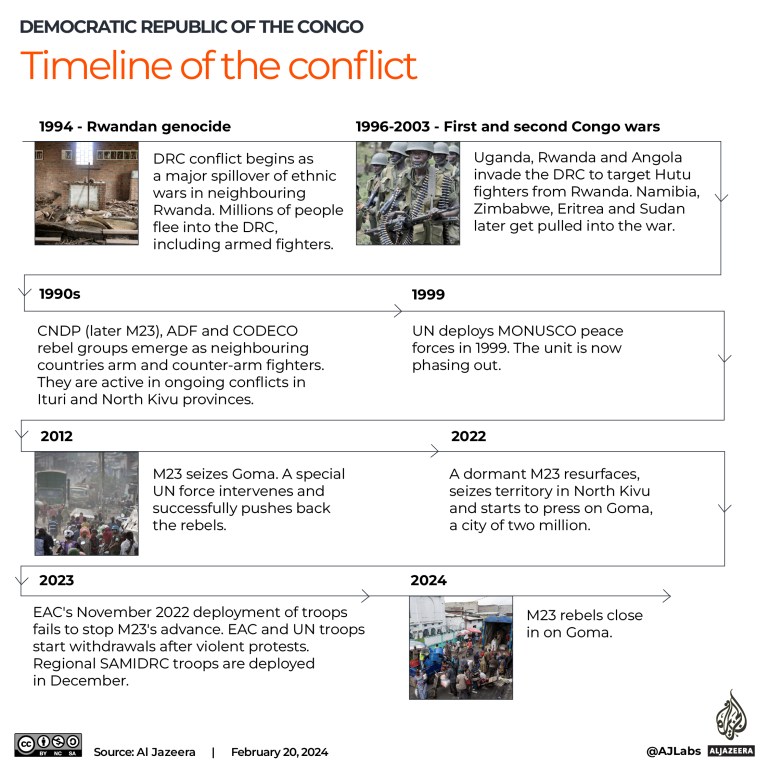
How did the 1994 Rwandan genocide affect the DRC?
- The DRC crisis originally began as a result of a series of post-colonial battles for power after independence from Belgium in 1960, which culminated in the assassination of popular leader Patrice Lumumba and the three-decade military rule under dictator Mobutu Sese Seko.
- Ethnic tensions in Rwanda forced more than 300,000 people from the Tutsi minority group to flee to neighbouring countries in the 1960s, particularly to the DRC. Some of those refugees regrouped and sought to seize power in Rwanda after the country gained independence from Belgium in 1962.
- In the early 1990s, the DRC saw a spillover of civil war and subsequent genocide in neighbouring Rwanda. In October 1990, a civil war broke out after the Rwandan Patriotic Front (RPF), a Tutsi rebel group led by current Rwandan President Paul Kagame, invaded the country from its Ugandan base. In April 1994, extremist Hutu militias attacked Tutsis and moderate Hutus, killing 800,000 to a million people over 100 days in what is now known as the Rwandan genocide. Hutus form some 80 percent of Rwanda’s population.
- Kagame’s RPF seized the capital, Kigali, on July 4 as Hutu genocidaires, troops, and former regime leaders fled to the DRC. An estimated two million Hutu civilians fearing revenge and reprisal attacks also poured into the country.
What led to the First Congo War of 1996-1997?
- Tensions rose between local Congolese tribes, Rwandan emigrants from the colonial and pre-1960 independence periods, and those who fled the 1994 war. Often, local tribes battled Tutsis, but conflicts also existed with the Hutus, as locals feared they would be outnumbered. Earlier emigrants had rights to Congolese citizenship, but later emigrants were regarded as refugees and many were housed in camps.
- Hutu militias who fled Kagame’s rule to refugee camps in eastern DRC began to regroup to restore a Hutu government in Kigali. They launched attacks on Rwanda and also killed Tutsis inside the Congo. In response, Rwanda started to arm Tutsi militias inside the DRC.
- Across the DRC, many Congolese were resentful of Mobutu’s corrupt rule. Rebel groups seeking to overthrow him emerged, including the Alliance of Democratic Forces for the Liberation of Congo (AFDL), led by Laurent-Desire Kabila.
- Rwanda, which accused Mobutu of harbouring Hutu perpetrators of genocide, armed the rebels and sent in Rwandan troops in 1996.
- On October 24, 1996, the Tutsi-dominated AFDL in Kivu and troops of the Rwandan army launched offensives in eastern DRC, sparking the First Congo War. Uganda, Eritrea, Angola, and Burundi – all Rwandan allies – joined the war.
- The AFDL seized power on May 17, 1997, ending the fighting, and Kabila declared himself president of the DRC. But the Rwandan troops allegedly massacred Hutu populations, forcefully repatriated Tutsis, and took control of lucrative diamond and coltan mines in the resource-rich eastern region bordering Rwanda.
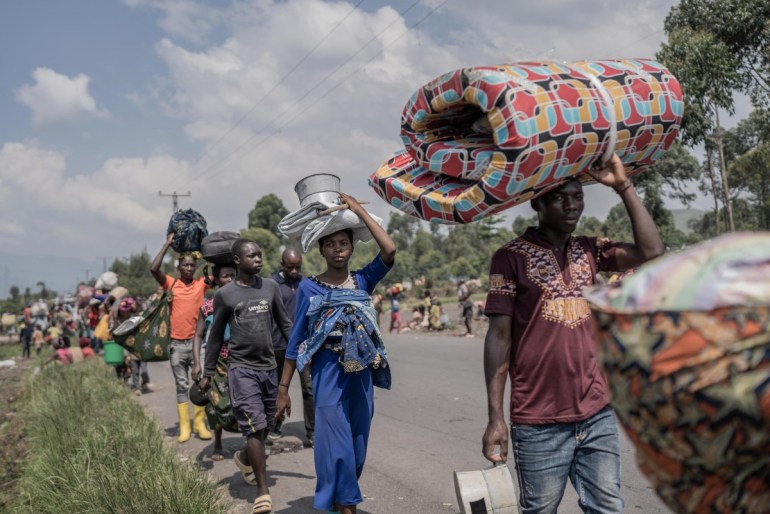
People carry some of their belongings as they flee the Masisi territory following clashes between M23 rebels and government forces at a road near Sake on February 7, 2024 [Aubin Mukoni/AFP]
What caused the 1998-2003 Second Congo War?
- After his climb to power, Kabila fell out with Kagame and started to unceremoniously force out Rwandan and other foreign troops still in the DRC. This alarmed ethnic Tutsis living in Congo and reignited tensions with local tribes.
- In response, Rwanda backed a new rebel group, the Rally for Congolese Democracy (RCD) which launched a revolt in August 1998 and started the Second Congo War. A parallel group, the Movement for the Liberation of Congo (MLC) formed to fight alongside the RCD, also seeking to overthrow Kabila.
- The DRC and rights groups claim MLC was backed by Uganda, which had also fallen out with the Kabila regime. Jean-Pierre Bemba, the present Congolese minister of defence, led the armed group that has now morphed into an opposition political party.
- Kabila’s government armed Hutu refugees in the east to fight back against Rwanda and RCD. Government officials publicly incited Congolese people to attack Tutsis, leading to several public lynchings. The South African Development Community (SADC) of which the DRC is a member, deployed troops from Zimbabwe, Namibia, and Angola to fight RCD and Rwandan troops.
- In 1999, the DRC, Uganda and Rwanda signed a set of ceasefire agreements, including the Lusaka Ceasefire Agreement (1999) and the Luanda Agreement (2002) which were to see all sides stop military operations. The agreements also triggered the UN to deploy MONUSCO (United Nations Organization Stabilization Mission in the Democratic Republic of the Congo) troops to monitor the peace process.
- However fighting persisted in many areas like gold-rich Ituri, where ethnic tensions, worsened by the war, erupted into the continuing Ituri conflict.
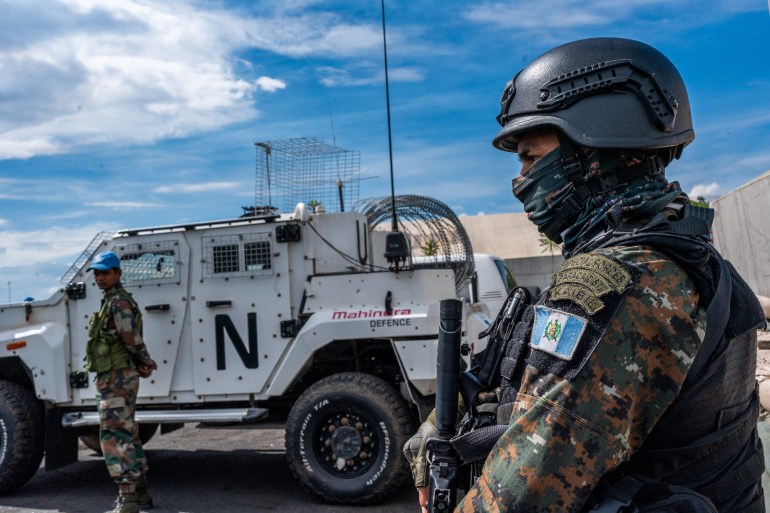
A peacekeeper of the United Nations Organization Stabilization Mission in the Democratic Republic of the Congo looks on at the force’s base during a field training exercise in Sake, eastern Democratic Republic of Congo on November 06, 2023. [Glody Murhabazi/AFP]
How did M23 and other major rebel groups emerge?
- The arming and counter-arming of rebel militias by the Congolese government and foreign actors means there are now between 120 to 140 rebel groups operating in the DRC, mostly in the resource-rich east and northeast areas.
- Several peace agreements with some of the groups over the years were meant to see operations stop and fighters integrate with the Congolese Army but have failed to permanently end their activities. The latest was the East African Community-led Nairobi Peace Process (June 2022) and the Luanda Roadmap (November 2022).
The most active armed groups at the moment are the M23, CODECO, and ADF.
M23: Operating in North Kivu province, the group takes its name from the March 23 Agreement of 2009 when the DRC government, under President Joseph Kabila — son of Laurent-Désiré Kabila — signed a ceasefire treaty with the Tutsi-majority National Congress for the Defence of the People (CNDP), one of the numerous groups of fighters active since the Second Congo War. In the agreement, the CNDP was meant to become a political party and its fighters were to integrate into the Congolese military, FARDC.
However, on April 4, 2012, 300 CNDP troops revolted, complaining of poor treatment in the army. They formed the M23, claiming to be fighting for Tutsis’ rights in the DRC. In late 2012, M23 launched an offensive, seizing Goma and several other towns. A special UN force along with FARDC pushed the rebels back into the eastern hills on the border with Rwanda in 2013.
M23 resurfaced in 2022 with violent attacks and has seized at least four towns in North Kivu. The group briefly withdrew from occupied towns in January 2023 as part of the Nairobi Peace Process, but the ceasefire fell apart in October. The DRC accuses Rwanda of funding M23. A 2023 UN Group of Experts report also found that Kigali finances the group. Rwanda denies the allegations.
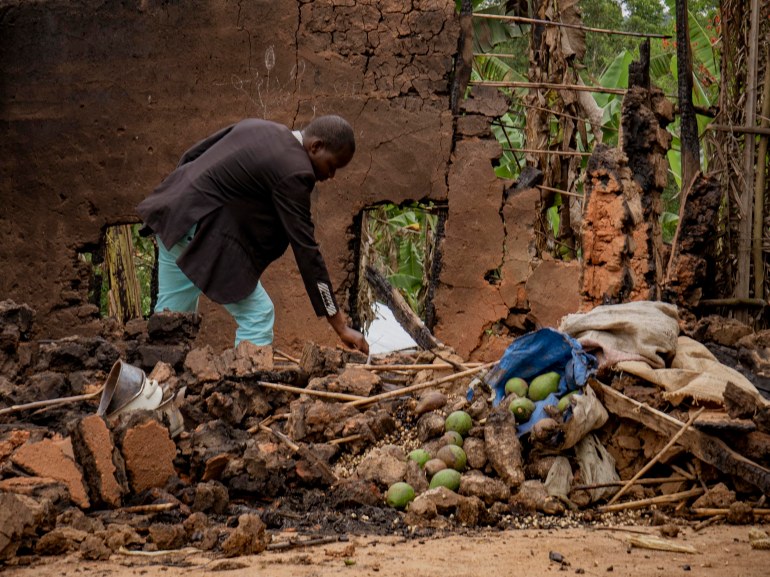
ADF: Originally from Uganda, the Allied Democratic Forces (ADF) also operates in the eastern DRC, in the regions bordering Uganda. The group initially claimed to be fighting for an Islamic state in Uganda where Muslims make up a minority of between 15 and 35 percent. It’s not clear what boundaries the reclusive ADF wants to claim, but the group first settled in Buseruka, western Uganda, before it was pushed back into the DRC. But it has recruited along secular lines over the years. Formed in 1996, during the First Congo War, it used a weak DRC as its base to launch attacks into Uganda. Ugandan troops used their presence in the DRC during the two wars to attack ADF fighters. The group went dormant in 2001 and resurfaced in 2013. It’s now reportedly linked to the ISIL (ISIS) armed group.
CODECO: The Cooperative for Development of the Congo (CODECO) was formed in 1999 during the Second Congo War, and operates in eastern Ituri. It was initially an agricultural cooperative but started to advocate for the Lendu ethnic group, who believed they were unfairly dominated by the rival Hema ethnic group. After a period of dormancy, CODECO launched offensives in 2017 and has continued to attack local civilians and Congolese forces. In February 2024, CODECO ambushed civilians, killing 15 people believed to be Hema in a likely continuation of the rivalry. The group has also targeted gold mines in recent weeks.
Other actors: Also operating are several pro-government militias and “Mai Mai” vigilante groups jointly called the Wazalendos, fighting with the Congolese Army. Some 40,000 Wazalendos have undergone military training since 2022, when current President Felix Tshisekedi called for young Congolese to help defend the country.
There’s also the Democratic Forces for the Liberation of Rwanda (FDLR), an ethnic Hutu group active since the final years of the Second Congo War and backed by the Congolese Army, according to a UN Experts Group report. Some of its leaders took part in the 1994 Rwandan genocide.
FDLR, FARDC and Wazalendos have carried out extrajudicial civilian killings, sexual assaults and exploited local communities, Human Rights Watch said in 2022.
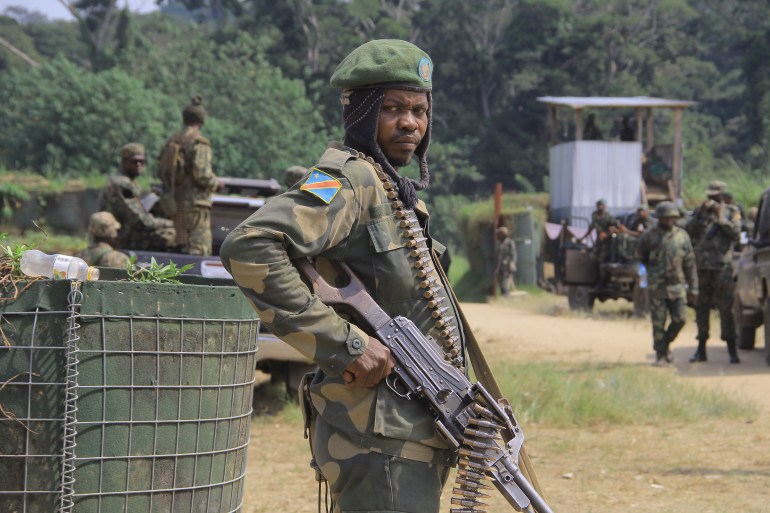
What’s the legacy of UN and regional peacekeepers?
- The UN peacekeeping mission MONUSCO is one of the most expensive and extensive UN missions in history, comprising 12,379 troops and about 5,000 additional civilian personnel. Its 2022 budget was about $1.1bn.
- But MONUSCO is deeply unpopular in the DRC, seen as having little to no impact. In 2022, violent protests erupted calling for its exit following renewed M23 attacks. At least 32 civilians and four peacekeepers were killed in the riots. Government officials, too, repeatedly called for their exit.
- In December 2023, the UN Security Council voted to pull out MONUSCO a year earlier than planned, despite fears the troops’ absence would create security vacuums and more instability. A phased withdrawal will see 2,000 personnel leave South Kivu by April 2024, and the entire contingent leave by December 2024.
- Similar issues have plagued regional military missions. In 2022, the East African Community, which the DRC is part of, deployed troops as part of the EAC Regional Force (EACRF). The force, led by Kenya, was meant to facilitate the Nairobi Process (a 2022 ceasefire agreement) by ensuring the withdrawal of multiple rebel groups from occupied territories in eastern DRC, including M23. But within months, the DRC government of Felix Tshisekedi accused the contingent of colluding with rebels and not launching offensives. The presence of Rwandan troops in the force also raised alarm in Kinshasa. Barely a year later, the troops are now evacuating.
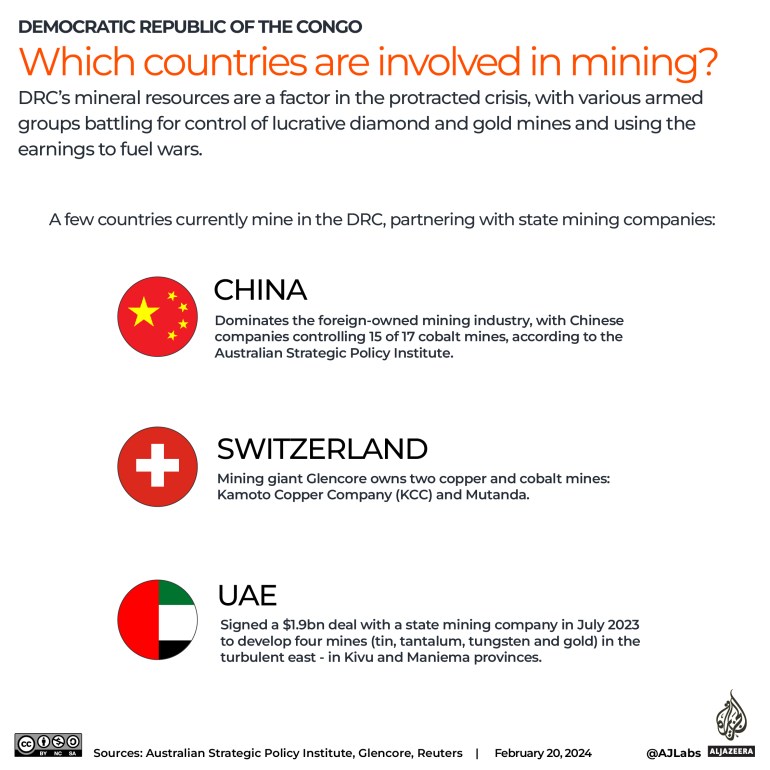
What’s the impact of mining on the conflict??
- DRC is home to some of the world’s largest reserves of metals and rare earth minerals like cobalt, considered essential in the lithium-ion batteries that power electric vehicles (EVs). As much as 70 percent of the world’s cobalt supply comes from the DRC. Coltan, used in gadgets like PlayStations and phones, is also plentiful in eastern DRC.
- Mineral resources have long been a factor in the protracted crisis with various armed groups battling for control of lucrative diamond and gold mines and using the earnings to fund wars. Leaders of these groups have been accused of child labour in the mines and of attacking and exploiting mining communities. During the civil wars, Rwandan and Ugandan troops looted DRC’s minerals, although only Kampala was forced by the International Court of Justice (ICJ) to pay reparations to the DRC for the economic damage caused.
- A US law in 2010 forced companies to evaluate where their minerals are sourced from and reduce conflict minerals or so-called “blood diamonds” from global supply.
- A few countries currently mine in the DRC, partnering with state mining companies: China dominates, with its companies controlling 15 of 17 cobalt mines, according to the Australian Strategic Policy Institute. Chinese concessions are in return for infrastructure projects in the DRC. There’s also Switzerland-based Glencore which owns two copper and cobalt mines: Kamoto Copper Company (KCC) and Mutanda. Lastly, the United Arab Emirates signed a $1.9bn deal with a state mining company in July 2023 to develop four mines (with tin, tantalum, tungsten and gold) in the turbulent eastern Kivu and Maniema provinces.
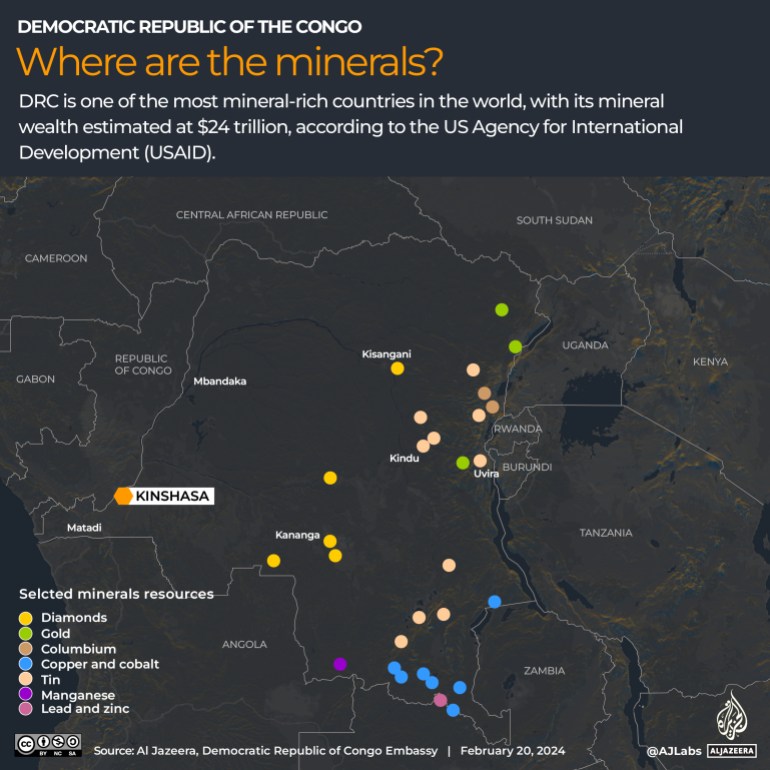
How is the conflict affecting Kigali-Kinshasa relationships?
- Tensions have escalated between presidents Tshisekedi and Kagame since the M23 resurgence in 2022. On the campaign trail for re-election in December, Tshisekedi called Kagame “Hitler” and threatened all-out war.
- Kinshasa, as well as the UN and the US, have accused Rwanda of supporting M23. Kigali in turn blames Kinshasa for arming the FDLR, one of the Hutu militias that sprung from the civil wars and that’s attacking Rwanda. Anti-Rwanda protests erupted in Goma in February, with demonstrators burning Rwandan flags, as well as those of Western countries seen to be backing Kigali.
- There are fears of a wider regional conflict stemming from the deteriorating relationships. Already, Kenya and Kinshasa had a heated row in December 2023 after a Congolese opposition candidate met with Congolese rebel forces in Nairobi.